Affiliate disclosure: This post may contain affiliate links. Please see our Privacy Policy.
Mead is a staple in our homebrew routine, and we’ve been making honey wines for over a decade. When it was time to brew another batch with rhubarb, I of course reached for the honey and started a bubbly honey-based batch of homemade rhubarb mead.
But wait…what if I want to taste the rhubarb, just the subtle delicious tangy notes of rhubarb, without the distraction and complexity of honey? Thus, why not. It’s time to make a rhubarb wine.
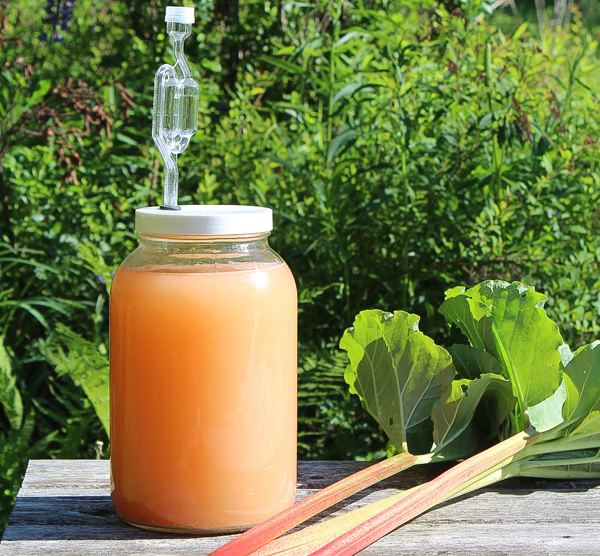
For my rhubarb mead, I left the whole chunks of rhubarb in the fermentation vessel for the duration and filtered just before bottling. Rhubarb wine called for a different technique, where I actually juiced the rhubarb by immersing it in sugar for several days. The sugar drew out the rhubarb juice, along with much of the beautiful red color.
The result was a lovely pink brew, with plenty of sweetness to balance out the tang.
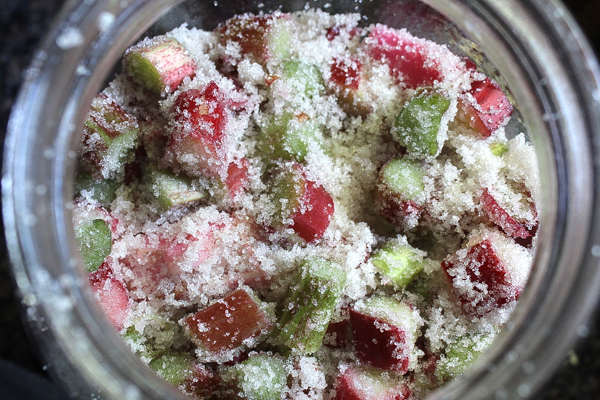
I started with a full gallon of rhubarb chunks, and at the end, I had about half a gallon of rhubarb juice. More accurately, I had about half a gallon of raw rhubarb syrup, since there was so much sugar in there you could almost stand a spoon in it.
I strained out the solid rhubarb pieces, and they still had quite a bit of flavor. The juice that had been removed was replaced by sugars, and they’d lost much of their bulk. They made a passable rhubarb candy, and my rhubarb harvesting assistant loved that there was a child-friendly byproduct of the whole rhubarb winemaking endeavor.
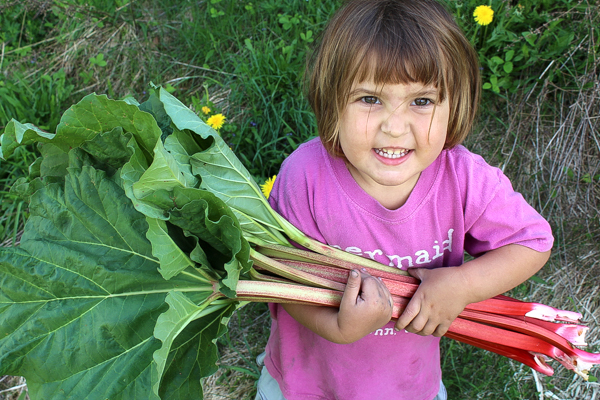
Instead of traditional narrow neck demijohns, I used my new favorite brewing vessel, a wide mouth one-gallon jar equipped with a waterlock.
I used the same setup for brewing dandelion wine earlier, and I was amazed at how easy it was to clean the whole thing. No tiny flower petal particles stuck in the fermenter after racking. Brilliant!
In the case of rhubarb wine, it means that I can toss all the rhubarb and sugar into the jar and cap it for juicing. The rhubarb is then strained out, and the juice is put back into the jar. The main benefit is that I only covered one thing with rhubarb and sugar, and I had a lid to keep the ants out of it while the sugar extracted the juice.
Feel free, of course, to extract the juice in whatever container you have, and then pour it into a traditional narrow-necked fermentation vessel. If you don’t have quite enough rhubarb, you can always make a small batch, using the same basic technique that’s used for one-quart batches of mead. Just divide all the ingredients in this recipe by 4 to make a super tiny 1-quart sampling batch.
Beyond the pile of rhubarb, which you should be able to harvest from a few healthy plants, you’ll also need some equipment for this recipe:
- One Gallon Fermentation Vessel with Airlock and Stopper (either Traditional or Wide Mouth Jar Version)
- Brewing Siphon and tubing – For moving the wine from one container to another without disturbing the sediment. This will allow for a much clearer finished rhubarb wine.
- Yeast Nutrient – Yeast cannot live on sugar alone, they need a number of micronutrients to do their important work. Grapes naturally have these nutrients, but other fruits don’t. If you’re making fruit wine, it’s always a good idea to add 1 tsp of yeast nutrient per gallon.
- Winemaking Tannin – While grapes have plenty of tannins to give a wine body and pleasant mouthfeel, rhubarb doesn’t. Adding a bit of tannin will create a much more pleasant, balanced wine. It doesn’t take much, usually around 1/4 to 1/2 tsp per gallon.
- Wine Yeast – Believe it or not, much of the flavor in a finished wine comes from the choice of yeast. Some produce volatile compounds that bring out fruity notes. Others like the champagne yeast I’ve chosen, produce a more neutral wine that ferments well in all conditions.
The end result is a light and bubbly sweet summer wine with a good bit of natural carbonation. (This Premier Classique yeast is also a good choice for rhubarb wine.)
If you’re new to winemaking, I’d suggest reading this primer on making small-batch wines to help get you started.
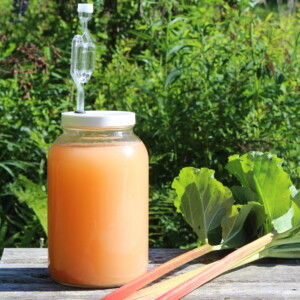
Rhubarb Wine
Ingredients
- 1- gallon rhubarb, chopped
- 3 lbs sugar
- 2-3 quarts water, to fill
- 1/4 tsp tannin powder
- 1 tsp yeast nutrient
- 1 wine yeast
Instructions
- Chop the rhubarb into 1/4 inch slices. Place the chopped rhubarb in a large bowl, glass jar or bucket.
- Cover with sugar and stir to coat. Allow the sugar to extract the rhubarb juice for 2-3 days.
- After 2-3 days, there will be about 1/2 gallon of rhubarb juice or rhubarb syrup. Strain the juice/syrup through a fine mesh strainer and measure the juice.
- Wash the remaining rhubarb chunks in enough water to make just under a full gallon of liquid. Strain again and add the rhubarb water to the fermentation vessel almost fill it up, leaving a bit of space for the remaining ingredients.
- Add the winemaking tannin and yeast nutrient and stir to dissolve.
- Dissolve the yeast packet in a small amount of lukewarm water and allow it to bloom for 5 minutes before adding it to the fermentation vessel.
- Allow the rhubarb wine to ferment at room temperature for about 6 weeks. If you choose, rack the wine into another fermentation vessel after about 2 weeks, leaving the sediment behind. This will result in a less cloudy finished wine.
- Once fermentation is complete, use a siphon to bottle the wine leaving behind any sediment. While you can drink it immediately, it’s better if you can bring yourself to wait at least a month.
Notes
Nutrition
Nutrition information is automatically calculated, so should only be used as an approximation.
More Winemaking Recipes
Looking for more easy winemaking recipes? Try any of these:
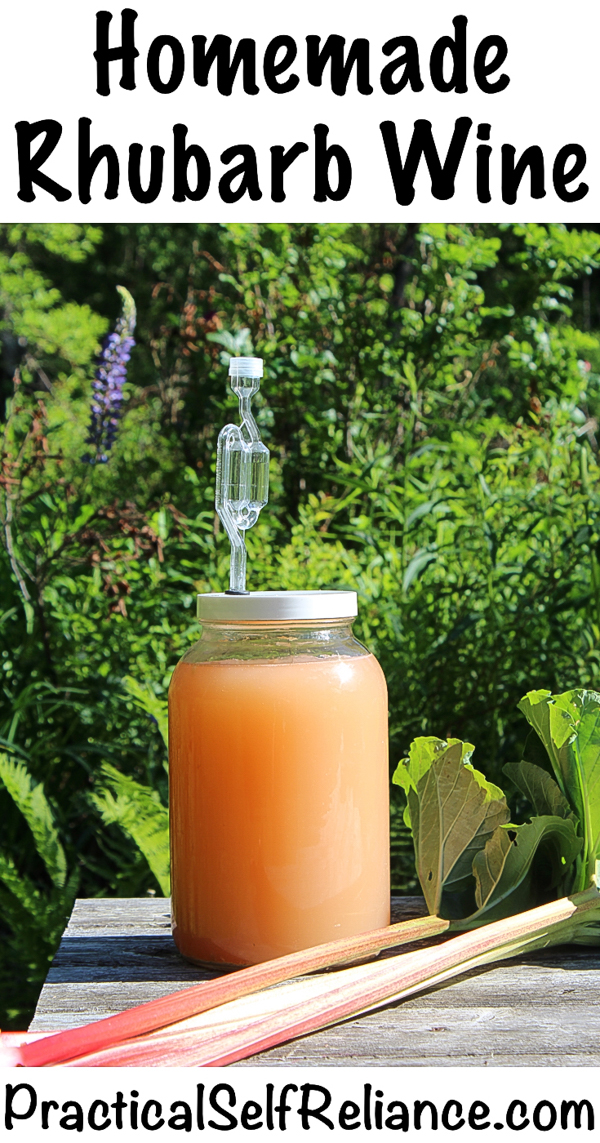
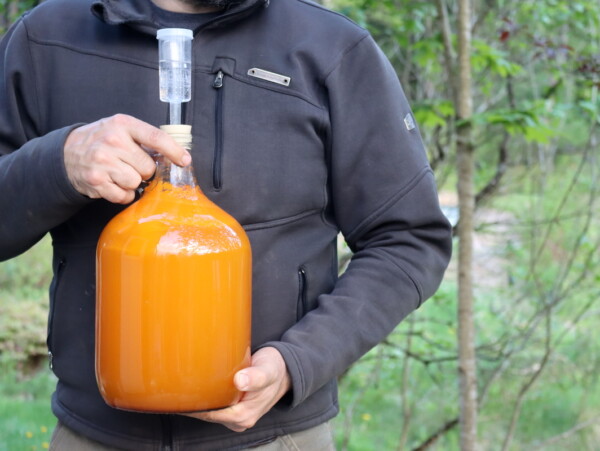
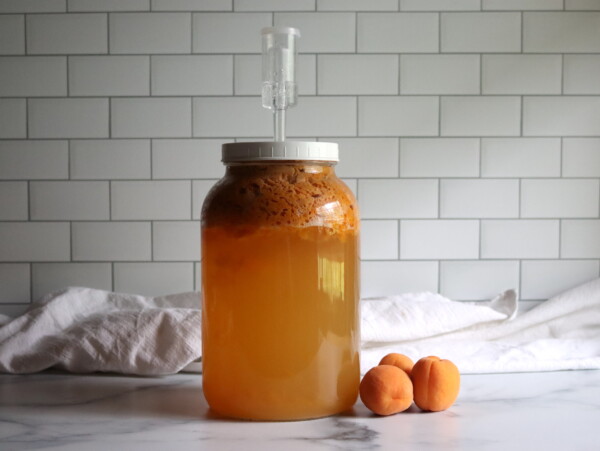
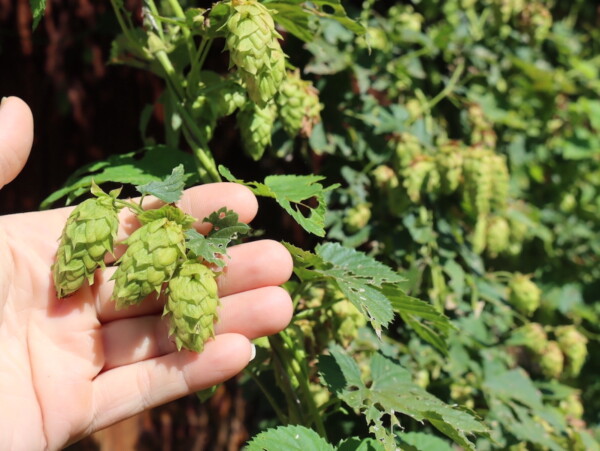
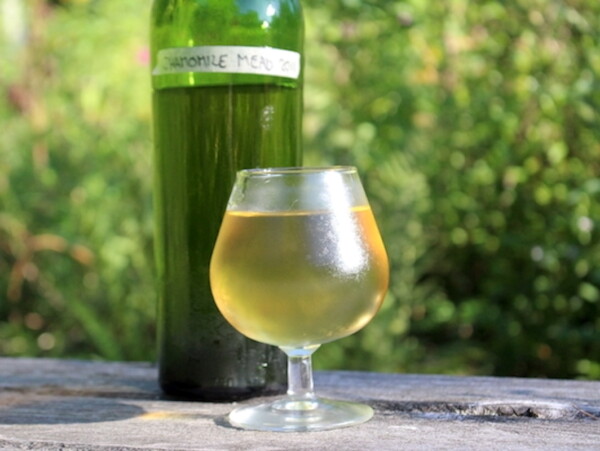
Have made rhubarb wine regularly over the years. Usually end up turning it into a sparkling wine via the “methode champenoise”. Have never added tannin but will try that with the batch I am starting this weekend and I usually forget to add yeast nutrient but never had any issues with good quality dried yeasts (eg Lalvin). Current batch is using over 3 Kg of frozen rhubarb from the 2023 and 2024 harvests that have been taking up far too much room in our freezer! Need to make room for this seasons fruit crops and space for the ice cream maker mixing tub so we can make more ice cream.
Recipes I have seen usually have the sugar quantity as weight for weight with the rhubarb, or slightly less. Your recipe is going purely on rhubarb volume and using the smaller US gallon measure (3.8 litres). So results will vary depending on the density of the rhubarb affecting the weight for a given dry volume. Maybe ok with fresh chopped rhubarb. The 3.4 Kg quantity I am using today did not all fit into my 1 imperial gallon (4.5 litre) fermenting tub whilst frozen but did so once defrosted, as a lot of it is juice already. So instead of your 3 lbs of sugar, I am using 3.4 Kg (7.5 lbs). I have still to decide whether to make one gallon of wine with a fairly concentrated rhubarb liquor or water it down a bit and make two gallons. Will check the Specific Gravity / Brix readings once the sugar has done its work and extracted as much juice as possible from the rhubarb. It is currently in a larger 5 gallon beer fermentation tub until it gets strained in a few days. The other decision I need to make is whether to add the yeast now, and let it work away before straining off the rhubarb pulp, or wait until I strain off the juice. The latter makes it easier to monitor the SG/Brix readings but adding yeast now may add to the rhubarb flavour.
That’s the main difference between making fruit wines and making true grape wine, the addition of water. You just crush and press the grapes to get as much juice as possible and ferment it with only yeast added. Although even professional vineyards often add sugar to raise the starting specific gravity to a desired level, depending on the sweetness of the grapes at harvest time and adding campden tablets or powder is necessary to stop oxidation before the yeast is added.
We do have a 30 year old grape vine in our greenhouse that in a good year has produced 25 lbs (11 Kg) of grapes. That can translate into two imperial gallons of wine or 12 bottles. After pressing the grapes I usually soak the pulp in boiling water and leave it a couple of days before straining it and adding sugar and yeast to produce a Grape Pomace Wine – some years it is as good as any bottled wine.
I noticed among the comments a question about campden tablets. Basically these are a standard measure of sodium metabisulphide. Apart from adding one or two per gallon at the bottling stage to preserve the wine long term, these are usually also added when fruit is first pulped to prevent it oxidising and to kill off any wild yeasts and such like already present. Unless you seriously overdose the pulp, good wine yeasts can be safely added after 24 hours as they are much more robust than wild yeasts from the air.
Thanks for all that great information!
I didn’t want to throw away the still good candied rhubarb so I made a rhubarb crumble AND IT WAS DELICIOUS. Now to wait 6 weeks to try the wine.
Awesome!
Thank you so much for the recipe! This is my first ever batch of wine! I am just about ready to bottle it and hopefully enjoy it over the holidays! My version is a bit too dry for my taste, so I decided to back sweeten it just a bit and its wonderful! Thank you for the easy to follow instructions!
You’re very welcome. So glad you enjoyed the recipe.
I just started my first batch…I am interested in the rhubarb candy…do tell!!!
We had a recipe linked on the post for dehydrator recipes but it looks like the post is no longer there. You should be able to do a quick internet search and find a ton of recipes.
Hi! I’m making this wine for the first time I’m so excited to try it! We have way too much rhubarb in our patch and this looks like a great way to use it up. I was wondering, for the juicing step where the rhubarb is sitting in the sugar, should I leave that at room temperature or keep it in the refrigerator? Thanks!
It’s totally fine to keep this at room temperature.
Greetings from Whitestar, Michigan. Thanks so much, Ashley for the great wine and mead recipes….I enjoy them every summer. The best to you and your family.
You’re very welcome. So glad you’re enjoying the recipes.
Can I use a sugar substitute like monk fruit or stevia to add to the rhubarb?
You can use these to sweeten the finished wine if you wish but you really should use sugar for the fermentation process.
Thank you so much for your reply. Every year I find myself with so much rhubarb and running out of ideas to use it ,,:) Usually share it with friends and neighbors.
You’re very welcome. It’s always great to share with friends and neighbors.
I believe that the sugar feeds the yeast and it is what converts it all to alcohol. I know; I’d rather not use sugar, but it’s necessary. I felt better when I looked up the carb count of wine and realized it wasn’t as high as I was expecting at all. Being pre-diabetic, I have a new appreciation for tracking sugar.
I love this site and all your recipes! I especially appreciate how patient and gracious you are to all your commenters! Thank you!
I’m making this rhubarb wine as my first batch ever. Everything has gone as planned, but when I racked it into a 1 gallon carboy, it only filled to the shoulder of the vessel. Should I top it off with another wine to cut down on the surface exposed to air? TIA!
You’re very welcome. So glad you’re enjoying the content. There is no need to top it off.
After adding the sugar, do I stir the rhubarb every day or let it sit for a few weeks? Making rhubarb wine, not exactly sure when to strain the rhubarb and put in a fermenter with airlock container!
You add the sugar to the rhubarb and let it sit for 2 to 3 days with no stirring to extract the juice. After 2 to 3 days you will strain the juice and add it to your fermentation vessel with the other ingredients. If you scroll to the very bottom of the post, you will see a recipe card along with step by step instructions. Let me know if you have any other questions.
Hi,
Do you stir everything after you add the yeast to the jar, or just pour it in and leave it?
Yes, you should stir it after adding the tannin and yeast.
Hello! I just started my batch and I used raisins for it! How long should the raisins be in for? Should I rack them out after a certain amount of time?
You can rack it into a new fermentation vessel after about 2 weeks leaving the raisins and any sediment behind in the first vessel.
Made this and the 6th month test bottle was a big hit. Pale pink, no strong alcohol bit, sharp but pleasant after taste. Mine finished at 10.5 avb. Waiting patiently for 1 year test. Definitely on my make again list.
That’s good to hear. I’m so glad you enjoyed it.
When I have the rhubarb and sugar together to draw out the juice, does that have to be refrigerated? Or can it just sit on the counter?
It can sit on the counter given that it’s not a terribly long time there. There’s so much sugar that it should inhibit fermentation for a while (until you add the water in the recipe, which reduces the sugar and allows it to start fermenting), so it should be totally fine to leave it out while you’re macerating the fruit. Or at least, that’s my opinion. That may not be true if you asked a food safety scientist.
Is there a reason why you added yeast nutrient for the wine but not for the mead?
With the honey and the fruit in the mead, the yeast has enough micronutrients to feed on.
I have a big #5 crock. My dad used to put his fruit (usually grapes) in that, cover with cheesecloth and then a plate to weigh it down. Can I ferment the chopped up rhubarb and sugar, etc. In this way?
You sure can.
Thank you so much for the reply!!! I’m so excited to start making my own wine; wish my dad were here to give me tips and tricks and to ultimately share a glass with me!!
I sure enjoy your wonderful and helpful information!!!
Michelle
I am so glad that you are getting started. What a great way to connect with your dad even after he is gone.
Got through the setup phase last night, and this morning it is bubbling away. It seems like it is so vigorous that sediment is coming up. It has turned the water in the waterlock brown and I have brown sediment on the cap. Is this OK?
You definitely want to be sure that the sediment does not clog up your waterlock.
I have 3 huge rhubarb plants I never know what to do with. Every year I make a crumble or 2 and post on local groups for people to come get some. This year one of my takers said she was going to try making rhubarb wine, and I was delighted to have a new idea! I am totally new to this however, and you don’t mention anything about needing to sterilize equipment. I have made jam before, and usually boil everything, but some of the equipment I bought is plastic. I found one article about using bleach in water, but it didn’t say at what ratios. Can you share a bit about what method you use? Or have you written a post about it?
Here is an article that walks you through the process of making small batches of wine which will be great if you are just starting out. It goes through all of the equipment and supplies that you will need. https://practicalselfreliance.com/small-batch-wine/ Then once you get a little more experience and find out what flavors you like, you can move on to bigger batches. You can get a brewers no-rinse cleanser to clean all of your equipment here. https://www.amazon.com/Strange-Brew-1Step-8oz-One-Step/dp/B0064O7VYY/ref=as_li_ss_tl?keywords=no+rinse+cleanser+for+brewing&qid=1566996594&s=gateway&sr=8-6&linkCode=sl1&tag=selfrelianc0e-20&linkId=52ef7d061ebb82597fee134db07c2eb6&language=en_US
Thanks! The only issue is I have our rhubarb harvested and ready to go, and we are leaving for over a week on Saturday. Do you have any advice about using bleach if you are in a pinch? The earliest that product would come from Amazon is June 14. I could boil the glass but am worried the plastic lids and plastic waterlocks would not hold up.
Do you have room in the freezer for your rhubarb until you return?
We already went ahead and did the first step last night. So for better or for worse we need to get it fermenting Friday night. 🙂 Turns out our dishwasher has a sanitizing setting, so we did that with no other actual dirty dishes mixed with what we needed. Hopefully that is good enough! We will get the other stuff or when it is time to bottle. If you have any other better advise for the fermentation step, let me know!
Here is an article on making small-batch wines which is great for a beginner. https://practicalselfreliance.com/small-batch-wine/ Then once you get a little bit of experience and know which flavors you really like, then you can move on to bigger batches. For sanitizing equipment you can use a brewers no-rinse cleanser for all of your equipment like this one here. https://amzn.to/2W8HtUO